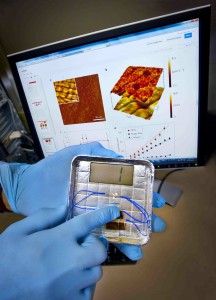A virus that converts mechanical energy to electricity and a new material that boosts the ability of batteries to store power are among the 38 "Oscars of Innovation" awards won this year by Department of Energy (DOE) national labs.
R&D Magazine has been presenting these prestigious awards for 51 years – recognizing outstanding technology research that has promising commercial potential.
Out of 100 awards across a variety of fields from medical research to energy, Sandia, Oak Ridge, NREL and Lawrence Berkeley Labs split 38 of them. Over the years, our national labs have won hundreds of awards.
Last week, House Republicans passed a significantly pared down budget for the Department of Energy.
Here are some of the labs award-winning technologies that are ripe for commercialization, along with other key recent accomplishments:
Lawrence Berkeley National Lab (LBNL) (8 awards):
Bacteriophage Power Generator: harnessing a virus to generate electricity. For the first time, biological material is producing energy that can power electronics and microdevices. Harmless viruses convert mechanical energy into electricity, providing a sustainable, cost-effective, nontoxic energy source.

It replaces toxic materials like lead, cadmium, and lithium and opens the door to applications in biomedical devices, particularly those implanted in the human body. It’s also a nano-manufacturing breakthrough – it makes use of the natural ability of a virus to synthesize materials that can self-assemble and self-replicate.
Last month, a database developed by the lab and Building Energy Inc launched that gives the public access to energy information on 60,000 residential and commercial buildings.
National Renewable Energy Lab (NREL) (3 awards):
Image Processing Occupancy Sensor: occupancy sensors are important building management systems that increase energy efficiency by providing just the right amount of light, ventilation, air conditioning or daylighting, for example. This detector can sense how may people are in an area, whether they are sitting or moving, or whether there’s no one there, among other factors, including whether security officers should be alerted.
Lowering the cost of solar: TetraSun, acquired by First Solar, worked with NREL, on a solar cell that combines higher efficiency, more streamlined, lower cost manufacturing and the elimination of certain costly materials, such as silver. Until now, processes that raise solar conversion efficiency tended to be more expensive to manufacture.
Last month, NREL opened the first research facility dedicated to integrating renewable energy to the grid at utility-scale.
Oak Ridge National Lab (6 awards):
A collaboration with ClimateMaster has produced ClimateMaster Trilogy 40 Q-Mode Geothermal Heat Pump: a water-to-air geothermal heat pump that not only provides heating and cooling, but also heats the water in homes.
Oak Ridge is working with General Electric to develop wind turbines in the 10-15 megawatt range.
Sandia National Lab (3 awards):
Reducing Solar Glare: As use of solar energy spread there are increasing concerns over glare from solar installations and its impacts on pilots, air traffic controllers, and motorists. This web-based tool quickly locates a solar site, outlines the proposed array, and identifies glare throughout the year, calculating its intensity and size to predict potential ocular hazards. It can also predict annual energy production of proposed arrays and evaluate alternative designs, layouts, and locations to identify those configurations that maximize energy production while mitigating glare impact.
Yesterday we reported that Sandia is collaborating with Texas Tech University on the first wind technology testing site to examine the interaction among turbines in wind farms.
